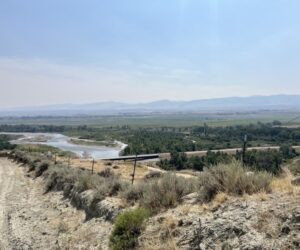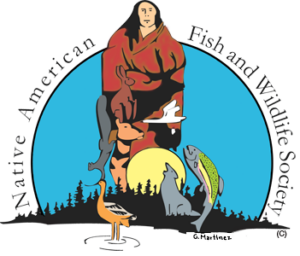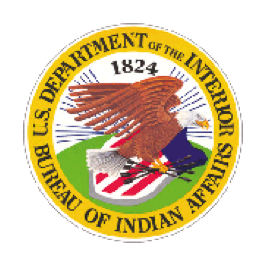Wind River Indian Reservation Awarded Funds for Buffalo Conservation and River Restoration
Utilizing funding awarded by the America’s Ecosystem Restoration Initiative competitive grant program for ecological restoration and cultural preservation, the Wind River Indian Reservation will begin planning for water and buffalo restoration.
 Wyoming – The National Fish and Wildlife Foundation (NFWF) announced the America’s Ecosystem Restoration Initiative (AERI) in 2022, establishing five years of grant funding to support state, territory, and Tribally-led ecosystem restoration. One of twenty-one Tribes awarded FY23 funding, the Wind River Indian Reservation is utilizing AERI funding to plan for river and riparian restoration and buffalo restoration, bringing them closer to their long-term goals.
Wyoming – The National Fish and Wildlife Foundation (NFWF) announced the America’s Ecosystem Restoration Initiative (AERI) in 2022, establishing five years of grant funding to support state, territory, and Tribally-led ecosystem restoration. One of twenty-one Tribes awarded FY23 funding, the Wind River Indian Reservation is utilizing AERI funding to plan for river and riparian restoration and buffalo restoration, bringing them closer to their long-term goals.
In August of 2024, the Native American Fish and Wildlife Society (NAFWS) America the Beautiful Challenge Field Liaisons Andy Edwards and Katie Schultz, Julie Thorstenson, Executive Director, and David Reis, Deputy Executive Director, joined Wind River AERI Project Staff to get a firsthand look at how the AERI program is supporting Tribal conservation efforts.
Wind River Indian Reservation
The Wind River Indian Reservation is unique in that it is shared by two Tribal Nations, the Eastern Shoshone and Northern Arapaho Tribes. While the Tribes have independent business councils, they also have a joint Wind River Inter-Tribal Council that is responsible for matters that affect the Reservation as a whole, including water, environment, land, and natural resources. The Wind River Indian Reservation consists of about 2.2 million acres, with 138,000 acres being designated as wilderness area with no roads or access by motor vehicle. Just 45 miles from Yellowstone National Park, the Reservation is a crucial piece of the greater Yellowstone ecosystem, providing incredible habitat for grizzlies, wolves, buffalo, pronghorn, fish, and much more.
The Big Wind River, which runs through the heart of the Wind River Indian Reservation, is facing severe depletion due to several dams and irrigation districts disrupting and diverting its flow. The volatile impacts of a changing climate have only augmented this problem, furthering the urgency to act. In response to these critical water issues, the Wind River
Indian Reservation Tribes and project partners, including Greater Yellowstone Coalition, Wind River Tribal Buffalo Initiative, and University of Wyoming, have come together to work under the umbrella of the Wind River Water and Buffalo Alliance and are initiating a planning process throughout the watershed. “The mission of the Greater Yellowstone Coalition – working with all people to protect the lands, water, and wildlife of the Greater Yellowstone Ecosystem – fits in with Indigenous values and beliefs. We believe water is life, buffalo is power, and food is healing. Our team is ready to help the Eastern Shoshone and Northern Arapaho elevate Tribal conservation priorities within this important corner of the Greater Yellowstone Ecosystem. We are honored that they have chosen us to assist in this effort as a partner.” -Wes Martel, GYC Senior Wind River Conservation Associate
Project activities will include community meetings aimed at discussing river and riparian restoration, as well as key topics of Tribal self-determination and sovereignty. Additionally, stream restoration planning for Crow Creek, a key tributary of the Big Wind River, and hydrological restoration planning at Crowheart Warm Springs will take place. Efforts to reintroduce beavers to the landscape to enhance natural water storage in the Big Wind River will be made along the way.

Wes Martel, Greater Yellowstone Coalition Senior Wind River Conservation Associate, explains the issues that dams and irrigation diversion cause in the Big Wind River to Dr. Julie Thorstenson, NAFWS Executive Director.
The Crow Creek Camp property has been identified as a future site for growing the current buffalo herds. Buffalo are a species of cultural significance to the Eastern Shoshone and Northern Arapaho Tribes, integrated into their teachings at all life stages. Buffalo also serve as a crucial food source, and the two Tribes currently maintain about 200 head in two separate herds. The buffalo restoration activities of this AERI project contribute to the long-term goal of establishing a contiguous herd of over 1,000 buffalo on the Reservation with unrestricted access to about 300,000 acres of range that is currently operated as cattle leases.
The project also emphasizes the importance of community involvement. Engaging Tribal members from Elders to youth is a key component, with the Crow Creek Camp property serving as a field trip destination. The project hopes to facilitate Traditional Ecological Knowledge (TEK) sharing and educate the community about the ongoing water and buffalo restoration efforts.

At the Crow Creek Camp property, the group discussed the potential for additional buffalo to be introduced and the riparian restoration that would occur along Crow Creek.
Restoring the connection between Tribal Members and their environment is a top priority for the Wind River Tribes. The comprehensive approach of this project aims to ensure a sustainable future for both the river and the people who depend on it.
“We need to begin addressing the impacts of drought and climate change that we have seen in recent years and work with the Elders and communities of both Tribes to make sure the coming generations have a reliable source of clean water. This planning grant from the National Fish and Wildlife Foundation will enable the TWE Office and tribal communities to start developing an understanding of the challenges that lie ahead as we seek to protect lands, water, and wildlife and our connection to Mother Earth.” – Lokilo St. Clair, Acting Tribal Water Engineer for the Wind River Reservation.
Supporting Tribal Conservation
In 2022 and 2023, Tribal Nations requested about $500 million through the America the Beautiful Challenge. NFWF and the agencies have committed to providing at least 10% of annual funds to Tribes. Thus far the quality of Tribal proposals has been rewarded with over a third of funds going to Tribal Nations! In the first two years NFWF has awarded 35 projects, to Tribal Nations, totaling about $76 million. While this amount is significant, the disparity between requested and awarded funding demonstrates the need for long-term, sustainable funding for Tribal conservation and restoration.
About Us
 NAFWS is the only national Tribal organization with a specific focus on Tribal fish and wildlife resources. As a unique membership organization with 227 Support Member Tribes in 7 regions, NAFWS strives to meet the needs of its Individual Members and Member Tribes through conferences, trainings, youth education, and by participating with innovative projects and initiatives in Indian Country.
NAFWS is the only national Tribal organization with a specific focus on Tribal fish and wildlife resources. As a unique membership organization with 227 Support Member Tribes in 7 regions, NAFWS strives to meet the needs of its Individual Members and Member Tribes through conferences, trainings, youth education, and by participating with innovative projects and initiatives in Indian Country.
Disclaimer: This project is made possible through a grant from the National Fish and Wildlife Foundation.
Disclaimer: The text of this article has been changed to reflect the new name of the America’s Ecosystem Restoration Initiative. For more information on this change, please contact Megan Hawkins, [email protected].






